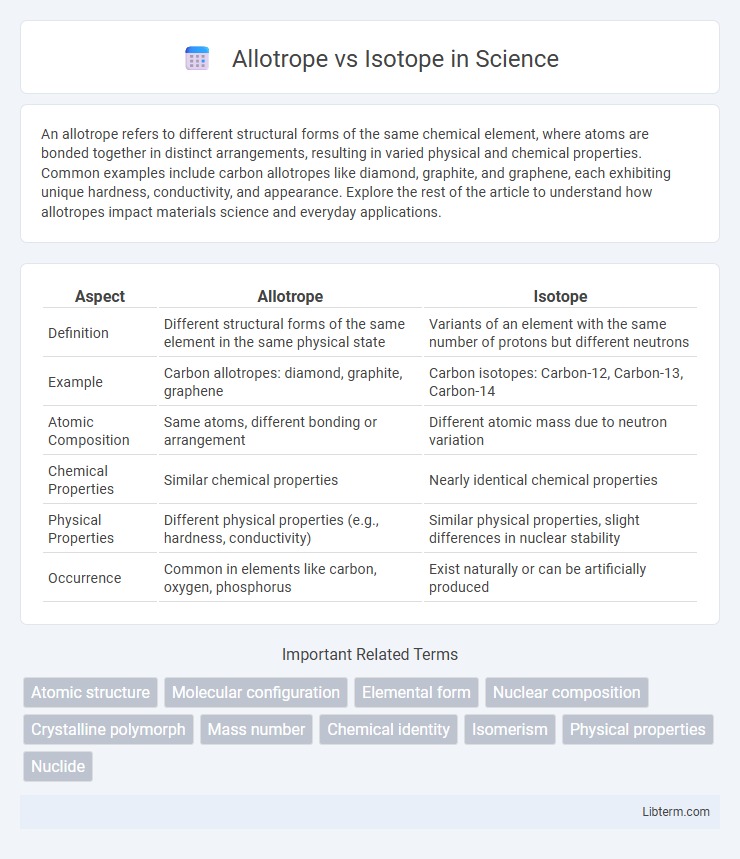An allotrope refers to different structural forms of the same chemical element, where atoms are bonded together in distinct arrangements, resulting in varied physical and chemical properties. Common examples include carbon allotropes like diamond, graphite, and graphene, each exhibiting unique hardness, conductivity, and appearance. Explore the rest of the article to understand how allotropes impact materials science and everyday applications.
Table of Comparison
| Aspect | Allotrope | Isotope |
|---|---|---|
| Definition | Different structural forms of the same element in the same physical state | Variants of an element with the same number of protons but different neutrons |
| Example | Carbon allotropes: diamond, graphite, graphene | Carbon isotopes: Carbon-12, Carbon-13, Carbon-14 |
| Atomic Composition | Same atoms, different bonding or arrangement | Different atomic mass due to neutron variation |
| Chemical Properties | Similar chemical properties | Nearly identical chemical properties |
| Physical Properties | Different physical properties (e.g., hardness, conductivity) | Similar physical properties, slight differences in nuclear stability |
| Occurrence | Common in elements like carbon, oxygen, phosphorus | Exist naturally or can be artificially produced |
Introduction to Allotropes and Isotopes
Allotropes are different structural forms of the same element, exhibiting distinct physical and chemical properties due to variations in atomic arrangement, such as graphite and diamond forms of carbon. Isotopes are variants of a chemical element that share the same number of protons but differ in neutron count, impacting atomic mass without altering chemical behavior, like carbon-12 and carbon-14. Understanding these concepts highlights how atomic structure influences material characteristics and isotopic applications in dating and nuclear science.
Definition of Allotropes
Allotropes are different structural forms of the same chemical element, existing in the same physical state but exhibiting distinct physical and chemical properties due to varying atomic arrangements. For example, carbon allotropes include diamond, graphite, and graphene, each with unique bonding patterns and characteristics. Unlike isotopes, which differ in neutron number, allotropes differ solely in their molecular or crystal structure.
Definition of Isotopes
Isotopes are variants of a chemical element that share the same number of protons but differ in the number of neutrons within their atomic nuclei. These nuclear variations result in isotopes having nearly identical chemical properties but distinct atomic masses and physical characteristics. Understanding isotopes is critical for applications in radiometric dating, nuclear medicine, and isotope geochemistry.
Key Differences Between Allotropes and Isotopes
Allotropes are different structural forms of the same element, such as carbon existing as diamond, graphite, or graphene, distinguished by variations in atomic arrangement and bonding. Isotopes, on the other hand, are variants of a single element that differ in neutron number, affecting atomic mass but not chemical properties, like carbon-12 and carbon-14. The key difference lies in allotropes varying in physical structure and chemical behavior, while isotopes differ primarily in nuclear composition and stability.
Examples of Common Allotropes
Common allotropes include carbon in the forms of diamond, graphite, and graphene, each exhibiting distinct physical properties due to variations in atomic bonding. Oxygen exists as the allotropes dioxygen (O2), essential for respiration, and ozone (O3), which plays a critical role in atmospheric protection. Phosphorus shows multiple allotropes such as white, red, and black phosphorus, differing widely in reactivity and structure.
Examples of Common Isotopes
Common isotopes include Carbon-12 and Carbon-14, both variants of the element carbon distinguished by differing neutron counts. Oxygen also exhibits common isotopes such as Oxygen-16, Oxygen-17, and Oxygen-18, which vary in atomic mass but share chemical properties. Another notable example is Hydrogen, with isotopes Protium, Deuterium, and Tritium, each differing in neutron number and nuclear stability.
Formation and Properties of Allotropes
Allotropes form when an element exists in two or more different physical forms due to variations in atomic arrangement or bonding, resulting in distinct structural and chemical properties. For example, carbon allotropes such as diamond and graphite differ significantly in hardness, electrical conductivity, and crystal structure due to differences in covalent bonding and lattice configuration. These variations influence properties like density, melting point, and reactivity, which are critical in applications ranging from industrial manufacturing to electronics.
Formation and Properties of Isotopes
Isotopes are formed when atoms of the same element have different numbers of neutrons, resulting in variations of atomic mass but identical chemical properties. They exhibit unique nuclear properties such as stability or radioactivity, influencing their applications in dating, medical imaging, and nuclear energy. Isotopes maintain consistent electron arrangements, preserving elemental behavior while their nuclear differences define physical attributes and decay modes.
Significance in Science and Industry
Allotropes play a crucial role in materials science and industry by exhibiting distinct physical and chemical properties, such as the hardness of diamond versus the conductivity of graphite, enabling diverse applications from cutting tools to advanced electronics. Isotopes are significant in medicine and nuclear energy, with radioactive isotopes used in diagnostic imaging, cancer treatment, and as fuel in nuclear reactors, highlighting their impact on healthcare and energy sectors. Both allotropes and isotopes fundamentally contribute to scientific research, material innovation, and technological advancements across various disciplines.
Summary and Conclusion: Allotrope vs Isotope
Allotropes are different structural forms of the same element in the same physical state, such as carbon existing as diamond and graphite, whereas isotopes are atoms of the same element with varying numbers of neutrons, affecting atomic mass but not chemical properties. Allotropes exhibit distinct physical and chemical characteristics due to their different molecular or crystal structures, while isotopes primarily differ in nuclear properties and stability. Understanding the differences between allotropes and isotopes is crucial for applications in chemistry, materials science, and nuclear physics.
Allotrope Infographic

 libterm.com
libterm.com